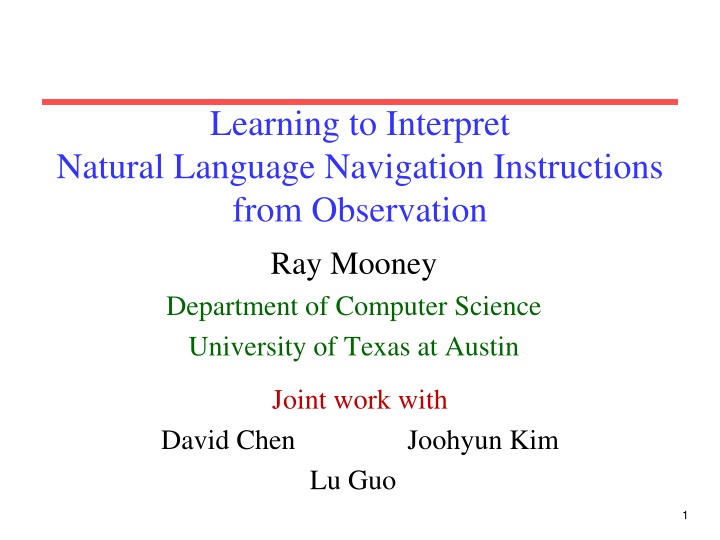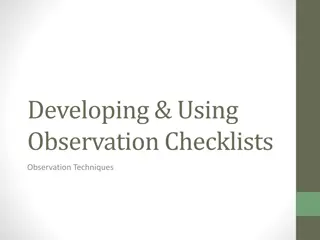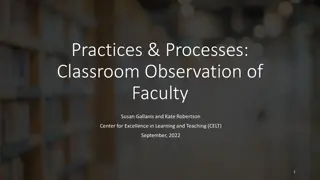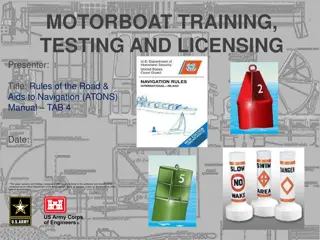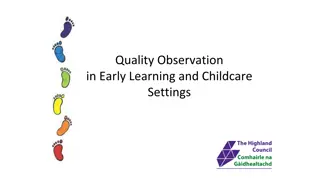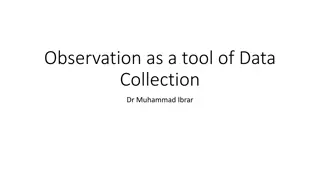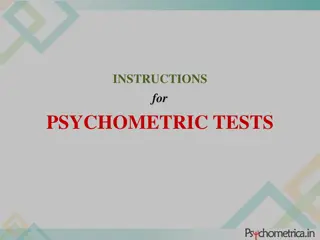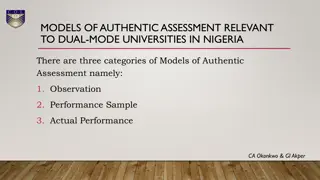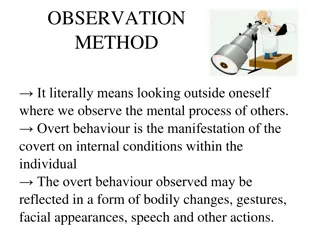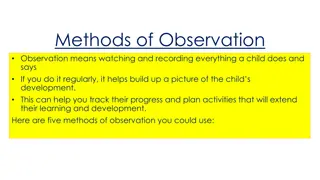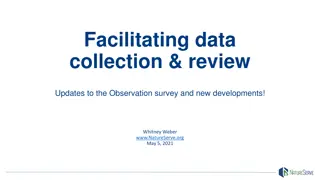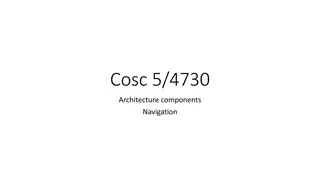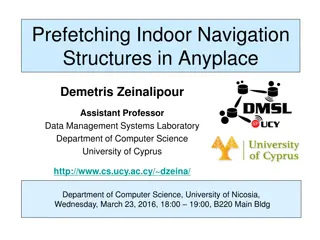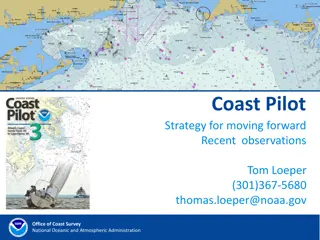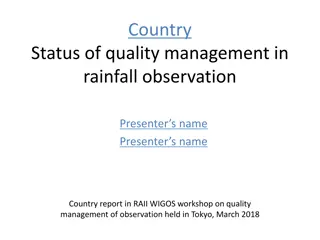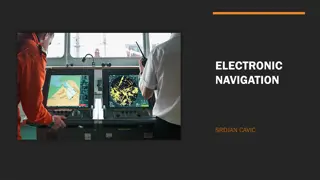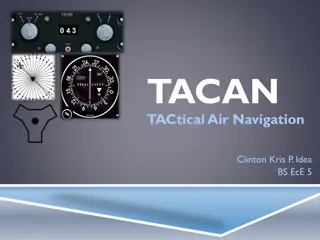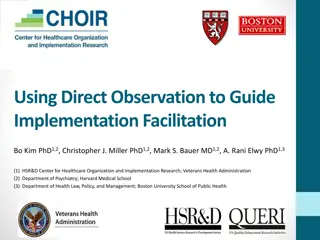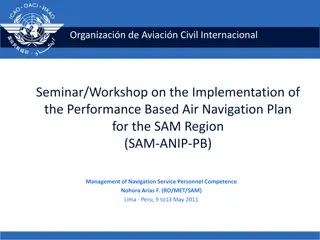Learning to Interpret Natural Language Navigation Instructions from Observation
This research focuses on developing a system that can interpret natural language navigation instructions by observing humans' actions in a virtual environment. The goal is to create virtual agents capable of understanding and following instructions in video games and educational software, all based on human demonstration. The study looks at sample environments, instructions, and observed training instances to formulate a formal problem definition for building a system that can accurately generate actions in response to unseen instructions.
Download Presentation

Please find below an Image/Link to download the presentation.
The content on the website is provided AS IS for your information and personal use only. It may not be sold, licensed, or shared on other websites without obtaining consent from the author.If you encounter any issues during the download, it is possible that the publisher has removed the file from their server.
You are allowed to download the files provided on this website for personal or commercial use, subject to the condition that they are used lawfully. All files are the property of their respective owners.
The content on the website is provided AS IS for your information and personal use only. It may not be sold, licensed, or shared on other websites without obtaining consent from the author.
E N D
Presentation Transcript
Learning to Interpret Natural Language Navigation Instructions from Observation Ray Mooney Department of Computer Science University of Texas at Austin Joint work with David Chen Joohyun Kim Lu Guo......... 1
Challenge Problem: Learning to Follow Directions in a Virtual World Learn to interpret navigation instructions in a virtual environment by simply observing humans giving and following such directions (Chen & Mooney, AAAI-11). Eventual goal: Virtual agents in video games and educational software that automatically learn to take and give instructions in natural language. 2
Sample Environment (MacMahon, et al. AAAI-06) H H Hat Rack L L Lamp E E Easel E C S Sofa S S C B B Barstool C - Chair H L 3
Sample Instructions Take your first left. Go all the way down until you hit a dead end. Go towards the coat hanger and turn left at it. Go straight down the hallway and the dead end is position 4. Start 3 Walk to the hat rack. Turn left. The carpet should have green octagons. Go to the end of this alley. This is p-4. End 4 H Walk forward once. Turn left. Walk forward twice. 4
Sample Instructions Take your first left. Go all the way down until you hit a dead end. Go towards the coat hanger and turn left at it. Go straight down the hallway and the dead end is position 4. Start 3 Walk to the hat rack. Turn left. The carpet should have green octagons. Go to the end of this alley. This is p-4. End 4 H Walk forward once. Turn left. Walk forward twice. Observed primitive actions: Forward, Left, Forward, Forward 5
Formal Problem Definition Given: { (e1, w1 , a1), (e2, w2 , a2), , (en, wn , an) } ei A natural language instruction wi A world state ai An observed action sequence Goal: Build a system that produces the correct aj given a previously unseen (ej, wj).
Observation World State Action Trace Instruction Training
Learning system for parsing navigation instructions Observation World State Navigation Plan Constructor Action Trace Instruction Training
Learning system for parsing navigation instructions Observation World State Navigation Plan Constructor Action Trace Instruction Semantic Parser Learner Training
Learning system for parsing navigation instructions Observation World State Navigation Plan Constructor Action Trace Instruction Semantic Parser Learner Training Testing Instruction World State
Learning system for parsing navigation instructions Observation World State Navigation Plan Constructor Action Trace Instruction Semantic Parser Learner Training Testing Instruction Semantic Parser World State
Learning system for parsing navigation instructions Observation World State Navigation Plan Constructor Action Trace Instruction Semantic Parser Learner Training Testing Instruction Semantic Parser World State Execution Module (MARCO) Action Trace
Representing Linguistic Context Context is represented by the sequence of observed actions each followed by verifying all observable aspects of the resulting world state. Turn Verify Travel Verify front: BLUE HALL front: SOFA steps: 2 at: SOFA LEFT 39
Possible Plans An instruction can refer to a combinatorial number of possible plans, each composed of some subset of this full contextual description. Turn Verify Travel Verify front: BLUE HALL front: SOFA steps: 2 at: SOFA LEFT 39
Possible Plan # 1 Turn and walk to the couch Turn Verify Travel Verify front: BLUE HALL front: SOFA steps: 2 at: SOFA LEFT 40
Possible Plan # 2 Face the blue hall and walk 2 steps Turn Verify Travel Verify front: BLUE HALL front: SOFA steps: 2 at: SOFA LEFT 41
Possible Plan # 3 Turn left. Walk forward twice. Turn Verify Travel Verify front: BLUE HALL front: SOFA steps: 2 at: SOFA LEFT 42
Disambiguating Sentence Meaning Too many meanings to tractably enumerate them all. Therefore, cannot use EM to align sentences with enumerated meanings and thereby disambiguate the training data. 43
Learning system for parsing navigation instructions Observation World State Navigation Plan Constructor Action Trace Instruction Semantic Parser Learner Training Testing Instruction Semantic Parser World State Execution Module (MARCO) Action Trace
Learning system for parsing navigation instructions Context Extractor Observation World State Action Trace Instruction Semantic Parser Learner Training Testing Instruction Semantic Parser World State Execution Module (MARCO) Action Trace
Learning system for parsing navigation instructions Context Extractor Observation World State Action Trace Lexicon Learner Instruction Semantic Parser Learner Training Testing Instruction Semantic Parser World State Execution Module (MARCO) Action Trace
Learning system for parsing navigation instructions Context Extractor Observation World State Action Trace Lexicon Learner Instruction Plan Refinement Semantic Parser Learner Training Testing Instruction Semantic Parser World State Execution Module (MARCO) Action Trace
Lexicon Learning Learn meanings of words and short phrases by finding correlations with meaning fragments. walk face Turn Verify Travel blue hall 2 steps front: BLUE HALL steps: 2 43
Lexicon Learning Algorithm To learn the meaning of the word/short phrase w: 1. Collect all landmark plans that co-occur with w and add them to the set PosMean(w) 2. Repeatedly take intersections of all possible pairs of members of PosMean(w) and add any new entries, g, to PosMean(w). 3. Rank the entries by the scoring function:
Graph Intersection Graph 1: Turn and walk to the sofa. Turn Verify Travel Verify front: BLUE HALL front: SOFA steps: 2 at: SOFA LEFT Graph 2: Walk to the sofa and turn left. Travel Verify Turn Verify front: BLUE HALL steps: 1 at: SOFA LEFT
Graph Intersection Graph 1: Turn and walk to the sofa. Turn Verify Travel Verify front: BLUE HALL front: SOFA steps: 2 at: SOFA LEFT Graph 2: Walk to the sofa and turn left. Travel Verify Turn Verify front: BLUE HALL steps: 1 at: SOFA LEFT Intersections: Turn Verify front: BLUE HALL LEFT
Graph Intersection Graph 1: Turn and walk to the sofa. Turn Verify Travel Verify front: BLUE HALL front: SOFA steps: 2 at: SOFA LEFT Graph 2: Walk to the sofa and turn left. Travel Verify Turn Verify front: BLUE HALL steps: 1 at: SOFA LEFT Intersections: Travel Verify Turn Verify front: BLUE HALL at: SOFA LEFT
Plan Refinement Use learned lexicon to determine subset of context representing sentence meaning. Face the blue hall and walk 2 steps Turn Verify Travel Verify front: BLUE HALL front: SOFA steps: 2 at: SOFA LEFT 43
Plan Refinement Use learned lexicon to determine subset of context representing sentence meaning. Face the blue hall and walk 2 steps Turn Verify Travel Verify front: BLUE HALL front: SOFA steps: 2 at: SOFA LEFT 43
Plan Refinement Use learned lexicon to determine subset of context representing sentence meaning. Face the blue hall and walk 2 steps Turn Verify Travel Verify front: BLUE HALL front: SOFA steps: 2 at: SOFA LEFT 43
Plan Refinement Use learned lexicon to determine subset of context representing sentence meaning. Face the blue hall and walk 2 steps Turn Verify Travel Verify front: BLUE HALL front: SOFA steps: 2 at: SOFA LEFT 43
Plan Refinement Use learned lexicon to determine subset of context representing sentence meaning. Face the blue hall and walk 2 steps Turn Verify Travel Verify front: BLUE HALL front: SOFA steps: 2 at: SOFA LEFT 43
Evaluation Data Statistics 3 maps, 6 instructors, 1-15 followers/direction Hand-segmented into single sentence steps Paragraph Single-Sentence # Instructions 706 3,236 Avg. # sentences 5.0 ( 2.8) 1.0 ( 0) Avg. # words 37.6 ( 21.1) 7.8 ( 5.1) Avg. # actions 10.4 ( 5.7) 2.1 ( 2.4)
End-to-End Execution Evaluation Test how well the system follows novel directions. Leave-one-map-out cross-validation. Strict metric: Only correct if the final position exactly matches goal location. Lower baselines: Simple probabilistic generative model of executed plans w/o language. Semantic parser trained on full context plans Upper baselines: Semantic parser trained on human annotated plans Human followers
End-to-End Execution Accuracy Single-Sentence Paragraph Simple Generative Model 11.08% 2.15% Trained on Full Context Trained on Refined Plans 21.95% 57.28% 2.66% 19.18% Trained on Human Annotated Plans 62.67% 29.59% Human Followers N/A 69.64%
Sample Successful Parse Instruction: Place your back against the wall of the T intersection. Turn left. Go forward along the pink-flowered carpet hall two segments to the intersection with the brick hall. This intersection contains a hatrack. Turn left. Go forward three segments to an intersection with a bare concrete hall, passing a lamp. This is Position 5. Parse: Turn ( ), Verify ( back: WALL ), Turn ( LEFT ), Travel ( ), Verify ( side: BRICK HALLWAY ), Turn ( LEFT ), Travel ( steps: 3 ), Verify ( side: CONCRETE HALLWAY )
Mandarin Chinese Experiment Translated all the instructions from English to Chinese. Single Sentences Paragraphs Trained on Refined Plans 58.70% 20.13% 64
Problem with Purely Correlational Lexicon Learning The correlation between an n-gram w and graph g can be affected by the context. Example: Bigram: the wall Sample uses: turn so the wall is on your right side with your back to the wall turn left Co-occurring aspects of context TURN() VERIFY(direction: WALL) But the wall is simply an object involving no action 40
Syntactic Bootstrapping Children sometimes use syntactic information to guide learning of word meanings (Gleitman, 1990). Complement to Pinker ssemantic bootstrapping in which semantics is used to help learn syntax. 41
Using POS to Aid Lexicon Learning Reason: dead end is often followed by the action of turning around to face another direction so that there is a way to go forward Annotate each n-gram, w, with POS tags. dead/JJ end/NN Annotate each node in meaning graph, g, with a semantic-category tag. TURN/Action VERIFY/Action FORWARD/Action 42
Constraints on Lexicon Entry: (w,g) The n-gram w should contain a noun if and only if the graph g contains an Object The n-gram w should contain a verb if and only if the graph g contains an Action dead/JJ end/NN dead/JJ end/NN Front/Relation WALL/Object TURN/Action VERIFT/Action FORWARD/Action 43
PCFG Induction Model for Grounded Language Learning (Borschinger et al. 2011) PCFG rules to describe generative process from MR components to corresponding NL words
Series of Grounded Language Learning Papers that Build Upon Each Other Kate & Mooney, AAAI-07 Chen & Mooney, ICML-08 Liang, Jordan, and Klein, ACL-09 Kim & Mooney, COLING-10 Also integrates Lu, Ng, Lee, & Zettlemoyer, EMNLP-08 Borschinger, Jones, & Johnson, EMNLP-11 Kim & Mooney, EMNLP-12 46
PCFG Induction Model for Grounded Language Learning (Borschinger et al. 2011) Generative process Select complete MR to describe Generate atomic MR constituents in order Each atomic MR generates NL words by unigram Markov process Parameters learned using EM (Inside-Outside) Parse new NL sentences by reading top MR nonterminal from most probable parse tree Output MRs only included in PCFG rule set constructed from training data 47
Limitations of Borschinger et al. 2011 PCFG Approach Only works in low ambiguity settings. Where each sentence can refer to only a few possible MRs. Only output MRs explicitly included in the PCFG constructed from the training data Produces intractably large PCFGs for complex MRs with high ambiguity. Would require ~1018 productions for our navigation data. 48
Our Enhanced PCFG Model (Kim & Mooney, EMNLP-2012) Use learned semantic lexicon to constrain the constructed PCFG. Limit each MR to generate only words and phrases paired with this MR in the lexicon. Only ~18,000 productions produced for the navigation data, compared to ~33,000 produced by Borschinger et al. for far simpler Robocup data. Output novel MRs not appearing in the PCFG by composing subgraphs from the overall context. 49
End-to-End Execution Evaluations Single Sentences Paragraphs Mapping to supervised semantic parsing Our PCFG model 57.28% 19.18% 57.22% 20.17% 50
